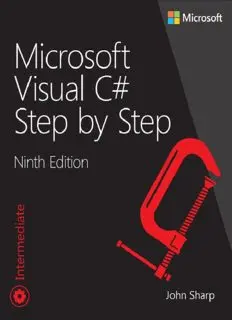Table Of ContentMicrosoft Visual C# Step by Step
Ninth Edition
John Sharp
Microsoft Visual C# Step by Step, Ninth Edition
Published with the authorization of Microsoft Corporation by: Pearson Education, Inc.
Copyright © 2018 by Pearson Education, Inc.
All rights reserved. This publication is protected by copyright, and permission must be obtained from the
publisher prior to any prohibited reproduction, storage in a retrieval system, or transmission in any form
or by any means, electronic, mechanical, photocopying, recording, or likewise. For information regarding
permissions, request forms, and the appropriate contacts within the Pearson Education Global Rights &
Permissions Department, please visit www.pearsoned.com/permissions/. No patent liability is assumed
with respect to the use of the information contained herein. Although every precaution has been taken in
the preparation of this book, the publisher and author assume no responsibility for errors or omissions.
Nor is any liability assumed for damages resulting from the use of the information contained herein.
ISBN-13: 978-1-5093-0776-0
ISBN-10: 1-5093-0776-1
Library of Congress Control Number: 2018944197
1 18
Trademarks
Microsoft and the trademarks listed at http://www.microsoft.com on the “Trademarks” webpage are
trademarks of the Microsoft group of companies. All other marks are property of their respective owners.
Warning and Disclaimer
Every effort has been made to make this book as complete and as accurate as possible, but no warranty or
fitness is implied. The information provided is on an “as is” basis. The author, the publisher, and
Microsoft Corporation shall have neither liability nor responsibility to any person or entity with respect
to any loss or damages arising from the information contained in this book.
Special Sales
For information about buying this title in bulk quantities, or for special sales opportunities (which may
include electronic versions; custom cover designs; and content particular to your business, training goals,
marketing focus, or branding interests), please contact our corporate sales department at
[email protected] or (800) 382-3419.
For government sales inquiries, please contact [email protected].
For questions about sales outside the U.S., please contact [email protected].
Editor-in-Chief
Brett Bartow
Acquisitions Editor
Trina MacDonald
Development Editor
Rick Kughen
Managing Editor
Sandra Schroeder
Senior Project Editor
Tracey Croom
Copy Editor
Christopher Morris
Indexer
Erika Millen
Proofreader
Jeanine Furino
Technical Editor
David Franson
Editorial Assistant
Courtney Martin
Cover Designer
Twist Creative, Seattle
Compositor
codemantra
Contents at a Glance
Acknowledgments
About the Author
Introduction
PART I INTRODUCING MICROSOFT VISUAL C# AND MICROSOFT VISUAL STUDIO
2017
CHAPTER 1 Welcome to C#
CHAPTER 2 Working with variables, operators, and expressions
CHAPTER 3 Writing methods and applying scope
CHAPTER 4 Using decision statements
CHAPTER 5 Using compound assignment and iteration statements
CHAPTER 6 Managing errors and exceptions
PART II UNDERSTANDING THE C# OBJECT MODEL
CHAPTER 7 Creating and managing classes and objects
CHAPTER 8 Understanding values and references
CHAPTER 9 Creating value types with enumerations and structures
CHAPTER 10 Using arrays
CHAPTER 11 Understanding parameter arrays
CHAPTER 12 Working with inheritance
CHAPTER 13 Creating interfaces and defining abstract classes
CHAPTER 14 Using garbage collection and resource management
PART III DEFINING EXTENSIBLE TYPES WITH C#
CHAPTER 15 Implementing properties to access fields
CHAPTER 16 Handling binary data and using indexers
CHAPTER 17 Introducing generics
CHAPTER 18 Using collections
CHAPTER 19 Enumerating collections
CHAPTER 20 Decoupling application logic and handling events
CHAPTER 21 Querying in-memory data by using query expressions
CHAPTER 22 Operator overloading
PART IV BUILDING UNIVERSAL WINDOWS PLATFORM APPLICATIONS WITH C#
CHAPTER 23 Improving throughput by using tasks
CHAPTER 24 Improving response time by performing asynchronous operations
CHAPTER 25 Implementing the user interface for a Universal Windows Platform app
CHAPTER 26 Displaying and searching for data in a Universal Windows Platform app
CHAPTER 27 Accessing a remote database from a Universal Windows Platform app
Index
Contents
Acknowledgments
About the Author
Introduction
PART I INTRODUCING MICROSOFT VISUAL C# AND MICROSOFT VISUAL STUDIO
2017
Chapter 1 Welcome to C#
Beginning programming with the Visual Studio 2017 environment
Writing your first program
Using namespaces
Creating a graphical application
Examining the Universal Windows Platform app
Adding code to the graphical application
Summary
Quick reference
Chapter 2 Working with variables, operators, and expressions
Understanding statements
Using identifiers
Identifying keywords
Using variables
Naming variables
Declaring variables
Specifying numeric values
Working with primitive data types
Unassigned local variables
Displaying primitive data type values
Using arithmetic operators
Operators and types
Examining arithmetic operators
Controlling precedence
Using associativity to evaluate expressions
Associativity and the assignment operator
Incrementing and decrementing variables
Prefix and postfix
Declaring implicitly typed local variables
Summary
Quick reference
Chapter 3 Writing methods and applying scope
Creating methods
Declaring a method
Returning data from a method
Using expression-bodied methods
Calling methods
Specifying the method call syntax
Returning multiple values from a method
Applying scope
Defining local scope
Defining class scope
Overloading methods
Writing methods
Refactoring code
Nesting methods
Using optional parameters and named arguments
Defining optional parameters
Passing named arguments
Resolving ambiguities with optional parameters and named arguments
Summary
Quick reference
Chapter 4 Using decision statements
Declaring Boolean variables
Using Boolean operators
Understanding equality and relational operators
Understanding conditional logical operators
Short-circuiting
Summarizing operator precedence and associativity
Using if statements to make decisions
Understanding if statement syntax
Using blocks to group statements
Cascading if statements
Using switch statements
Understanding switch statement syntax
Following the switch statement rules
Summary
Quick reference
Chapter 5 Using compound assignment and iteration statements
Using compound assignment operators
Writing while statements
Writing for statements
Understanding for statement scope
Writing do statements
Summary
Quick reference
Chapter 6 Managing errors and exceptions
Coping with errors
Trying code and catching exceptions
Unhandled exceptions
Using multiple catch handlers
Catching multiple exceptions
Filtering exceptions
Propagating exceptions
Using checked and unchecked integer arithmetic
Writing checked statements
Writing checked expressions
Throwing exceptions
Using throw exceptions
Using a finally block
Summary
Quick reference
PART II UNDERSTANDING THE C# OBJECT MODEL
Chapter 7 Creating and managing classes and objects
Understanding classification
The purpose of encapsulation
Defining and using a class
Controlling accessibility

